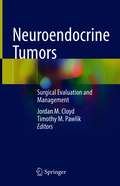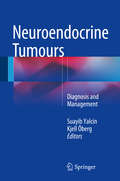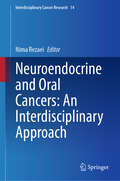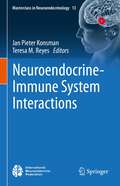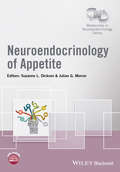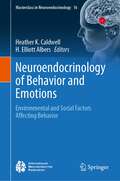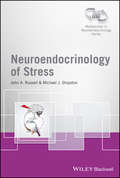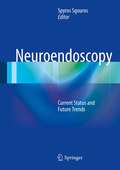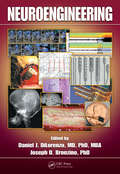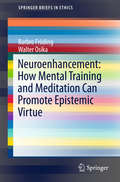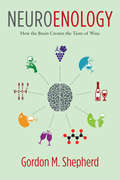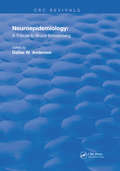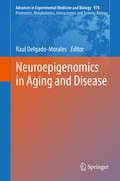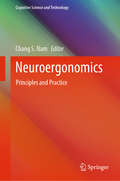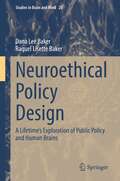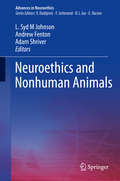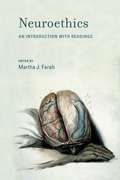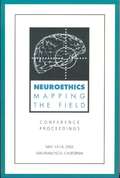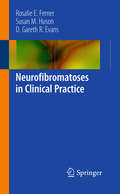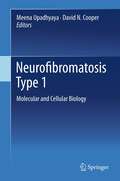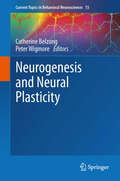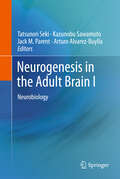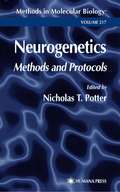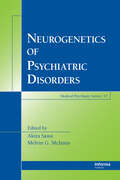- Table View
- List View
Neuroendocrine Tumors: Surgical Evaluation and Management
by Timothy M. Pawlik Jordan M. CloydThis book is a comprehensive, state-of-the art, definitive reference for the surgical management of Neuroendocrine Tumors (NETs). It provides a practical, clinically useful guide that prioritizes the diagnostic work-up, indications for surgery, surgical principles, and perioperative care of patients with NETs in the context of multi-disciplinary care. Most textbooks on NETs have traditionally focused on patients with advanced disease, highlighting systemic therapies and emerging treatment options. In contrast, this book provides a concise yet comprehensive summary of the surgical management of NETs and serves as an invaluable resource for physicians, fellows, and residents who treat this difficult disease by providing helpful guidelines and up-to-date information on clinical management. Written by experts in the field, Neuroendocrine Tumors includes the most up-to-date clinical information from national and international leaders in their respective disciplines. It not only serves as an invaluable resource for many as they seek to provide the best possible surgical and multidisciplinary cancer care, but also an opportunity to identify new avenues of scientific discovery that may lead to significant advances in the diagnosis and management of NETs.
Neuroendocrine Tumours
by Suayib Yalcin Kjell ÖbergThis book is a timely textbook that covers all aspects of neuroendocrine tumors (NET) from epidemiology, pathological classification and evaluation and molecular biology through to diagnostic imaging methods and therapeutic options, including the latest targeted therapies. The various types of NET are individually discussed, including carcinoid tumors, insulinomas, gastrinomas, glucagonomas, VIPomas, somatostatinomas, PPomas, medullary thyroid carcinomas, adrenocortical cancer, pheochromocytomas, paragangliomas and non-functioning pancreatic NETs. The contributing authors are internationally recognized experts who bring a wealth of experience to the subject. This book will be an invaluable source of information for practicing medical oncologists, surgeons, endocrinologists, gastroenterologists and pathologists and also trainees.
Neuroendocrine Tumours: Diagnosis and Management
by Suayib Yalcin Kjell ÖbergThe second edition of this important textbook covers all aspects of neuroendocrine tumors (NETs), from epidemiology, pathological classification and evaluation, and molecular biology through to diagnostic imaging methods and therapeutic options, including the latest targeted therapies and immunotherapies. Readers will find individual discussion of each of the various types of NET: gastrointestinal, lung, and pancreatic tumors such as insulinomas, gastrinomas, glucagonomas, VIPomas, somatostatinomas, PPomas, and non-functioning pancreatic NETs, as well as medullary thyroid carcinomas, pheochromocytomas, paragangliomas, etc. In addition to NETs, endocrine tumors such as thyroid tumors and adrenocortical tumors are also covered. The contributing authors are internationally recognized experts who bring a wealth of science and experience to the subject. This book will be an invaluable source of information for practicing medical oncologists, surgeons, endocrinologists, gastroenterologists, and pathologists as well as for trainees in these fields.
Neuroendocrine and Oral Cancers: An Interdisciplinary Approach (Interdisciplinary Cancer Research #14)
by Nima RezaeiThe “Neuroendocrine and Oral Cancers: An Interdisciplinary Approach” is the fourteenth volume of the “Interdisciplinary Cancer Research” series, publishes comprehensive volume on diagnosis and treatment of neuroendocrine tumors and oral cancers. The volume starts with a chapter on signaling pathways in neurological cancers and a general chapter on neuroendocrine neoplasms. Thyroid cancer and adrenal gland carcinoma as two examples of endocrine tumors are explained in this volume. The other chapters focus on oral cancers, where biomarkers for diagnosis and therapeutic opportunities are discussed. The last chapter also explains the challenges on oral and dental care on oncology. This is the main concept of Cancer Immunology Project (CIP), which is a part of Universal Scientific Education and Research Network (USERN). This interdisciplinary book will be of special value for neurologists, endocrinologists, dentists, oncologists who wish to have an update on diagnosis and treatment of endocrine tumors and oral cancers.
Neuroendocrine-Immune System Interactions (Masterclass in Neuroendocrinology #13)
by Jan Pieter Konsman Teresa M. ReyesThe concepts of the neuroendocrine system and the immune system emerged more or less simultaneously in the second half of the 20th century. Although these systems have a high degree of autonomy, it has also become clear that they interact in many ways and at different levels. This book focuses on the neuroendocrine and immune interactions that are fundamental to normal development and maintenance of health.The first introductory chapters are devoted to the historical and philosophical concepts within the field, as well as evolutionary considerations, offering critical interdisciplinary perspectives on the development of this field of research. Without attempting an exhaustive overview, the book then introduces some of the regulatory pathways that mediate interactions between the neuroendocrine and immune systems and examines modulating factors such as age and sex. In addition, several chapters address the importance of neuroendocrine-immune interactions in some disease states. Readers can expect to gain a broad perspective of neuroendocrine-immune interactions in development, health, and disease, along with a critical evaluation of current methods used in the field. Given its scope, the book is essential reading for undergraduate and graduate students with an interest in neuroendocrinology, neuroimmunology, and neuroscience, as well as postdoctoral fellows and established researchers seeking a comprehensive overview and historical perspective of the field of neuroendocrine-immune interactions.
Neuroendocrinology of Appetite
by Julian G. Mercer Suzanne L. DicksonThis cutting-edge, interdisciplinary volume describes established and state of the art approaches for exploring the pathways that influence and control appetite, including: behavioural, electrophysiological, neuroanatomical, gene knockout and pharmacological techniques. The book presents key peptide and neurotransmitter systems, together with newly emerging concepts of metabolic signalling and hypothalamic inflammation. The impact of early life experience on neuroendocrine appetite circuits is also looked at, including early programming of these circuits by circulating hormones. Finally, new emerging therapeutic approaches to appetite suppression are discussed, including those linked to bariatric (weight loss) surgery. Neuroendocrinology of Appetite is especially focused on established and emerging technologies and approaches for investigating appetite control. It is written so as to provide an overview of sufficient depth for an undergraduate or new scientist in the field to come up to speed in the complementary approaches used by researchers in this field. Taking an interdisciplinary approach, the book aims to appeal to all those with a basic, clinical or therapeutic interest in research into obesity and eating disorders.
Neuroendocrinology of Behavior and Emotions: Environmental and Social Factors Affecting Behavior (Masterclass in Neuroendocrinology #16)
by Heather K. Caldwell H. Elliott AlbersThis volume highlights current research on how the neuroendocrine system helps to influence emotional states and ultimately behavioral output. Social relationships and context-appropriate behavioral responses are important for the survival of most vertebrate species. These relationships can range from transient social interactions to strong social bonding between sexual partners and social behaviors can be observed and evaluated from the individual- to the group-level. Further, behavioral output is shaped by complex interactions between the physical environment, genetics, experience, and context, and are often modulated by the neuroendocrine system. In this book, experts in the field will provide a sweeping look at novel research in the neuroendocrine regulation of important behaviors ranging from parental care to social homeostasis, with a focus on comparative studies across vertebrate species. The first part of the book is dedicated to theneuroendocrinology of relationships, including the coordination of acoustic signals in songbirds, the complexity of social relationships in primates, and cooperation and parenting in humans. The second part of the book focuses on social behaviors and provides some insights into their regulation, including the neuroendocrine regulation of maternal behavior in rodents, the roles of oxytocin and vasopressin in the modulation of sex-specific social behavior, the interactions between adult neurogenesis, the neuroendocrine system and social behavior, and a consideration of neuroendocrine influences on reproductive decision making across species. The book concludes with a section on environmental influences on neuroendocrine systems underlying behavior, including how social isolation and endocrine disrupting chemicals affect the neuroendocrinology of behavior and emotions. Given its breadth, this volume is appropriate for undergraduate students, graduate students, postdoctoral researchers, and established researchers who are interested in neuroendocrinology and behavior. This is the sixteenth volume in the International Neuroendocrine Federation (INF) Masterclass in Neuroendocrinology series, which aims to illustrate the highest standards and highlight the latest technologies in basic and clinical research and aspires to provide inspiration for further exploration into the exciting field of neuroendocrinology.
Neuroendocrinology of Stress
by Michael J. Shipston John A. RussellExposure to chronic stress has cumulative adverse effects on physical and mental health, considered to be the consequence of chronic exposure to high levels of stress hormones. Consequently, there is extensive research in progress to investigate and better understand how the brain organises neuroendocrine stress responses and how interventions may be able to moderate these responses to improve mental and physical health. Neuroendocrinology of Stress highlights current knowledge of the organisation and physiology of these stress response systems, how the impact of dysregulation of these systems is being investigated, and considers the ways in which contributions to both psychiatric and physical diseases resulting from chronic stress effects can be critically addressed in basic research * Written by a team of internationally renowned researchers, each chapter presents a succinct summary of the very latest developments in the field* Both print and enhanced e-book versions are available* Illustrated in full colour throughout This is the second volume in a new Series 'Masterclass in Neuroendocrinology' , a co- publication between Wiley and the INF (International Neuroendocrine Federation) that aims to illustrate highest standards and encourage the use of the latest technologies in basic and clinical research and hopes to provide inspiration for further exploration into the exciting field of neuroendocrinology. Series Editors: John A. Russell, University of Edinburgh, UK and William E. Armstrong, The University of Tennessee, USA
Neuroendoscopy
by Spyros SgourosAs a result of technological improvements, neuroendoscopy is now used in the treatment of many more patients, enabling the performance of previously unavailable operations with low complication rates and rapid patient recovery. This book presents the distilled experience of world experts in this evolving field. Current applications in a wide variety of settings are explained in detail and likely future developments are identified. In addition, the available neuroendoscopic instruments are reviewed and the results of international trials and collaborative studies, presented. This book will fully acquaint the reader with the breadth and depth of available neuroendoscopy techniques and their impressive therapeutic potential. It should serve as the reference book on neuroendoscopy for the next 10 years.
Neuroengineering
by Joseph D. Bronzino Daniel J. DiLorenzoBased on a foundation of science and empirical observation, engineering research and design has brought science fiction into science fact. The convergence of neuroscience and technology is facilitating the development of therapies that not long ago would have seemed unimaginable, if not impossible. With contributions from pioneers in industry, acad
Neuroenhancement: how mental training and meditation can promote epistemic virtue.
by Barbro Fröding Walter OsikaThis book explores how one can bring about changes in the brain through meditation, both through attention-focus training and through compassion training. Recent findings in the natural sciences have confirmed that it is possible for humans to achieve these structural and functional changes through various life-style practices. It is argued that meditation enables us to influence some aspects of our biological make-up and, for example, could boost our cognitive flexibility as well as our ability to act compassionate. Such changes are likely to facilitate the instilling of a number of epistemic virtues which have great bearing on our quality of life. This book offers the reader an accessible introduction to a set of neuro-enhancement methods, with a special focus on meditation techniques, and explores how such practices could contribute to make us better decision-makers and improve our moral virtues. The book is suitable for anyone looking for a text discussing the effects of neuro-enhancement from a secular ethics perspective.
Neuroenology: How the Brain Creates the Taste of Wine
by Gordon ShepherdIn his new book, Gordon M. Shepherd expands on the startling discovery that the brain creates the taste of wine. This approach to understanding wine's sensory experience draws on findings in neuroscience, biomechanics, human physiology, and traditional enology. Shepherd shows, just as he did in Neurogastronomy: How the Brain Creates Flavor and Why It Matters, that creating the taste of wine engages more of the brain than does any other human behavior. He clearly illustrates the scientific underpinnings of this process, along the way enhancing our enjoyment of wine.Neuroenology is the first book on wine tasting by a neuroscientist. It begins with the movements of wine through the mouth and then consults recent research to explain the function of retronasal smell and its extraordinary power in creating wine taste. Shepherd comprehensively explains how the specific sensory pathways in the cerebral cortex create the memory of wine and how language is used to identify and imprint wine characteristics. Intended for a broad audience of readers—from amateur wine drinkers to sommeliers, from casual foodies to seasoned chefs—Neuroenology shows how the emotion of pleasure is the final judge of the wine experience. It includes practical tips for a scientifically informed wine tasting and closes with a delightful account of Shepherd's experience tasting classic Bordeaux vintages with French winemaker Jean-Claude Berrouet of the Chateau Petrus and Dominus Estate.
Neuroepidemiology: A Tribute To Bruce Schoenberg (Routledge Revivals)
by Dallas W. AndersonFirst published in 1991. This one-of-a-kind publication pays tribute to one of the pre-eminent scientists and educators in neuroepidemiology, Dr. Bruce Schoenberg. The goal of this book is to provide a comprehensive, state-of-the-art review of the work that has taken place in the field of neuroepidemiology over the last decade and address the challenges and prospects of the future. The work presented in this volume focuses on clinically relevant issues related to the magnitude, distribution, natural history, risk factors, treatment, and prevention of the more common neurologic disorders. It also emphasizes methodological problems that affect the design and implementation of studies, as well as the interpretation of results. The book's concise format provides quick access to the major results, difficulties, and challenges discussed within the text. Neuroepidemiology: A Tribute to Bruce Schoenberg should be considered an essential addition to the libraries of all clinical neurologists and epidemiologists.
Neuroepigenomics in Aging and Disease
by Raul Delgado-MoralesEpigenetic mechanisms (DNA modifications, histone alterations and non-coding RNAs) are crucial for transcriptional regulation and alterations of the "physiological epigenome" are increasingly associated with human diseases. During the last decade the emerging field of neuroepigenomics have started to impact tremendously in areas such learning and memory, addiction or neurodegeneration. This expert volume covers the role of epigenetic molecular mechanism in regulation of central nervous system's function, one of the most exciting areas of contemporary molecular neuroscience. The book describes the current knowledge on the epigenetic basis of human disease covering the complete lifespan: from neurodevelopment/childhood (Rett Syndrome, Rubinstein-Taybi, autism), adolescence (eating disorders, drug addiction, anxiety), adulthood (depression, schizophrenia, amyotrophic lateral sclerosis, Huntington's disease) and elderly (Alzheimer's disease, Parkinson's disease). The book also covers the three major players on neuroepigenomic mechanisms: histones alterations, DNA modifications and non-coding RNAs, their roles at the molecular and cellular level and the impact of their alterations on neuronal function and behavior. Finally, a special chapter on state-of-the-art technologies helps the reader not only to understand epigenetic driven changes in human cognition and diseases but also the methodology that will help to generate paradigm shifts on our understanding of brain function and the role of the neuroepigenome in human diseases.
Neuroergonomics: Principles and Practice (Cognitive Science and Technology)
by Chang S. NamThis book sums up key research findings, and theoretical and technological advances having a direct bearing on neuroergonomics. Neuroergonomics is an emerging area whose Neuroergonomics is an emerging area that is collectively defined as the study of human brain function and behaviour in relation to behavioural performance in natural environments and everyday settings. It helps readers to understand neural mechanisms of human cognition in the context of human interaction with complex systems, as well as understanding the change of perception, decision-making and training in humans. The authors give new insights into augmenting human performance, reflecting upon the opportunities provided through neuroergonomics research and development. Computer systems acting on data from behavioural-output, physiological, and neurological sensing technologies are used to determine the user’s cognitive state and adapt the systems to change, support, and monitor human cognition. Various domains and case studies delve into the field of neuroergonomics in detail. These include, but are not limited to:an evaluation of technologies in health, workplace, and education settings, to show the different impacts of neuroergonomics in everyday lives;assessment of real-time cognitive measures;dynamic casual interactions between inhibition and updating functions, through analysis of behavioral, neurophysiological and effective connectivity metrics; and applications in human performance modelling and assessment of mental workload, showing the reader how to train and improve working memory capacity.Neuroergonomics: Principles and Practice provides academic practitioners and graduate students with a single go-to handbook that will be of significant assistance in research associated with human factors and ergonomics, human-computer interaction, human-systems engineering and cognitive neuroscience.
Neuroethical Policy Design: A Lifetime’s Exploration of Public Policy and Human Brains (Studies in Brain and Mind #20)
by Dana Lee Baker Raquel Lisette BakerThis volume focuses on the emergent field of neuroethics comparing and contrasting how two democracies, Canada and the United States, have begun adapting public policy design to better fit human minds. The book focuses on issues relevant to all members of the general population and discusses a series of policy issues arranged roughly in the order in which they become relevant in a typical person’s lifetime. After the introductory chapter each chapter considers an area of public policy particularly relevant to a different stage of life—from early childhood education policy, to policies for higher education and the workplace, to end of life decisions in living wills and advance directives. The author puts forth that making the shift towards more neurologically appropriate policy will likely be a gradual process hampered primarily by two issues. The first is the inability of neuroscientists to come to agreement on increasingly sophisticated research findings. The second issue points out that bringing policy and neurology into a more synchronous relationship requires a commitment to prolonged effort involves the largely unrecognized reality of entrenched neurological interests. The first chapter introduces the concept of disconnect between policy design with traditional understandings of the brain and goes on to highlight developments in the science of human neurology in recent years. To help contextualize the book, examples of neurological misperceptions are explored in this introductory chapter. Chapters Two through Eleven each explores a specific type of policy, incorporating understandings of the human brain which, modern neuroscience suggests, are debatable.
Neuroethics and Nonhuman Animals (Advances in Neuroethics)
by Andrew Fenton L. Syd M Johnson Adam ShriverThis edited volume represents a unique addition to the available literature on animal ethics, animal studies, and neuroethics. Its goal is to expand discussions on animal ethics and neuroethics by weaving together different threads: philosophy of mind and animal minds, neuroscientific study of animal minds, and animal ethics. Neuroethical questions concerning animals’ moral status, animal minds and consciousness, animal pain, and the adequacy of animal models for neuropsychiatric disease have long been topics of debate in philosophy and ethics, and more recently also in neuroscientific research. The book presents a transdisciplinary blend of voices, underscoring different perspectives on the broad questions of how neuroscience can contribute to our understanding of nonhuman minds, and on debates over the moral status of nonhuman animals. All chapters were written by outstanding scholars in philosophy, neuroscience, animal behavior, biology, neuroethics, and bioethics, and cover a range of issues and species/taxa. Given its scope, the book will appeal to scientists and students interested in the debate on animal ethics, while also offering an important resource for future researchers. Chapter 13 is available open access under a CC BY 4.0 license at link.springer.com.
Neuroethics: An Introduction with Readings
by Martha J. Farah A. Robert Jean L. ToddieExplores the ethical, legal, and societal issues arising from brain imaging, psychopharmacology, and other new developments in neuroscience. Neuroscience increasingly allows us to explain, predict, and even control aspects of human behavior. The ethical issues that arise from these developments extend beyond the boundaries of conventional bioethics into philosophy of mind, psychology, theology, public policy, and the law. This broader set of concerns is the subject matter of neuroethics. In this book, leading neuroscientist Martha Farah introduces the reader to the key issues of neuroethics, placing them in scientific and cultural context and presenting a carefully chosen set of essays, articles, and excerpts from longer works that explore specific problems in neuroethics from the perspectives of a diverse set of authors. Included are writings by such leading scientists, philosophers, and legal scholars as Carl Elliot, Joshua Greene, Steven Hyman, Peter Kramer, and Elizabeth Phelps. Topics include the ethical dilemmas of cognitive enhancement; issues of personality, memory and identity; the ability of brain imaging to both persuade and reveal; the legal implications of neuroscience; and the many ways in which neuroscience challenges our conception of what it means to be a person. Neuroethics is an essential guide to the most intellectually challenging and socially significant issues at the interface of neuroscience and society. Farah's clear writing and well-chosen readings will be appreciated by scientist and humanist alike, and the inclusion of questions for discussion in each section makes the book suitable for classroom use. Contributors Zenab Amin, Ofek Bar-Ilan, Richard G. Boire, Philip Campbell, Turhan Canli, Jonathan Cohen, Robert Cook-Degan, Lawrence H. Diller, Carl Elliott, Martha J. Farah, Rod Flower, Kenneth R. Foster, Howard Gardner, Michael Gazzaniga, Jeremy R. Gray, Henry Greely, Joshua Greene, John Harris, Andrea S. Heberlein, Steven E. Hyman, Judy Iles, Eric Kandel, Ronald C. Kessler, Patricia King, Adam J. Kolber, Peter D. Kramer, Daniel D. Langleben, Steven Laureys, Stephen J. Morse, Nancey Murphy, Eric Parens, Sidney Perkowitz, Elizabeth A. Phelps, President's Council on Bioethics, Eric Racine, Barbara Sahakian, Laura A. Thomas, Paul M. Thompson, Stacey A. Tovino, Paul Root Wolpe
Neuroethics: Mapping the Field
by Steven J. MarcusThis volume contains the proceedings of a two-day multidisciplinary conference on the ethical implications of brain research organized by Stanford University and the University of California, San Francisco. Leaders in neuroscience, journalism, law, and philosophy, among other fields, engaged in a freewheeling debate on the social and individual effects of the research. Steven Marcus has edited their formal and informal deliberations to present a compelling first-hand account of the proceedings, providing a highly readable front-row seat about the first-ever symposium on neuroethics.
Neurofibromatoses in Clinical Practice
by D. Gareth Evans Susan Huson Rosalie E FernerNeurofibromatoses in Clinical Practice provides a succinct, accessible guide to the neurofibromatoses including diagnosis, management protocols and indications for referral to specialist centers. Neurocutaneous diseases are complex to diagnose and treat and many patients require specialist multidisciplinary management and surveillance. Due to multiple disease manifestations, patients can present to different clinicians without specialist expertise - general practitioners, pediatricians, neurologists, geneticists, surgeons and ophthalmologists. The clinically focused format will enable rapid consultation during clinics, facilitate disease pattern recognition, and indicate care pathways. The clinical quiz highlights common pitfalls in diagnosis and management and a glossary and reference section provide details for access to specialist NF clinics throughout the UK and internationally. Written by experts in the field Neurofibromatoses in Clinical Practice is a succinct and practical guide for consultants in training and practice, general practitioners and specialist nurses.
Neurofibromatosis Type 1
by Meena Upadhyaya David N CooperNeurofibromatosis type 1 (NF1), caused by mutational inactivation of the NF1 tumour suppressor gene, is one of the most common dominantly inherited human disorders, affecting 1 in 3000 individuals worldwide. This book presents in concise fashion, but as comprehensively as possible, our current state of knowledge on the molecular genetics, molecular biology and cellular biology of this tumour predisposition syndrome. Written by internationally recognized experts in the field, the 44 chapters that constitute this edited volume provide the reader with a broad overview of the clinical features of the disease, the structure and expression of the NF1 gene, its germ line and somatic mutational spectra and genotype-phenotype relationships, the structure and function of its protein product (neurofibromin), NF1 modifying loci, the molecular pathology of NF1-associated tumours, animal models of the disease, psycho-social aspects and future prospects for therapeutic treatment.
Neurogenesis and Neural Plasticity
by Catherine Belzung Peter WigmoreThis volume brings together authors working on a wide range of topics to provide an up to date account of the underlying mechanisms and functions of neurogenesis and synaptogenesis in the adult brain. With an increasing understanding of the role of neurogenesis and synaptogenesis it is possible to envisage improvements or novel treatments for a number of diseases and the possibility of harnessing these phenomena to reduce the impact of ageing and to provide mechanisms to repair the brain.
Neurogenesis in the Adult Brain II
by Arturo Alvarez-Buylla Tatsunori Seki Jack M. Parent Kazunobu SawamotoThe discovery of adult neurogenesis caused a paradigm shift in the neurosciences. For more than 100 years, it was believed that adult neurons do not regenerate. Joseph Altman and Fernando Nottebohm found proof to the contrary and changed the course of history. Their research, included here, provides the foundations of the field. Today, adult neurogenesis is a rapidly expanding discipline applicable to the study of brain development and diseases, learning and memory, aging, and neuropsychiatric disorders. With multiple authors, the 27 chapters of this book contain the latest work in two volumes. The first presents the basic biology of adult neurogenesis in non-mammalian vertebrates and in the mammalian hippocampus and olfactory bulb, and the second discusses clinical implications and delves into adult neurogenesis and brain injury as well as neurodegenerative and neuropsychiatric pathologies. With details of the anatomy, physiology, and molecular biology of the two neurogenic brain regions, this book provides indispensable knowledge for many areas of neuroscience and for experimental and clinical applications of adult neurogenesis to brain therapy.
Neurogenetics
by Nicholas T. PotterAn international panel of recognized academic physicians, researchers, and clinical laboratory diagnosticians describe their best methods for characterizing neurologically relevant genes, their mutations, and their proteins. Providing detailed step-by-step instructions to assure successful experimental results, these experts cover the key methods for mutation detection and screening, including discussions of quantitative PCR, trinucleotide repeat detection, sequence-based mutation detection, fluorescence in situ hybridization (FISH), in vitro protein expression systems, and studies of protein expression and function.
Neurogenetics of Psychiatric Disorders (Medical Psychiatry Series)
by Akira Sawa Melvin G. McInnisTranslating bench-based research into effective bedside practice, this source provides a clear understanding of the neurobiology and neurogenetics of psychiatric disorders, the genes responsible for specific psychiatric disorders, and the implications of genetic roots and underlying biology on the development of new diagnostic approaches and treatment therapies.
